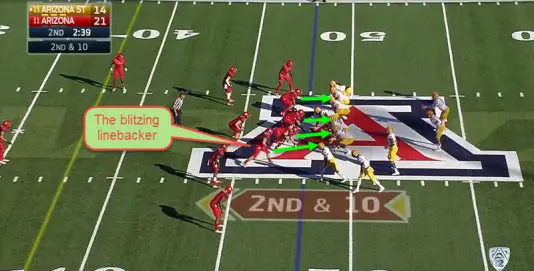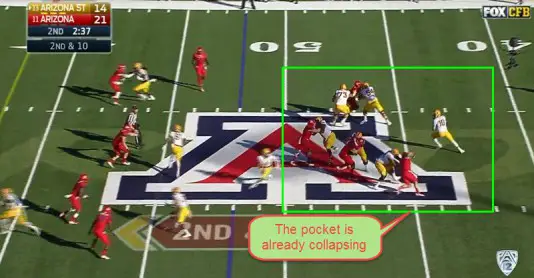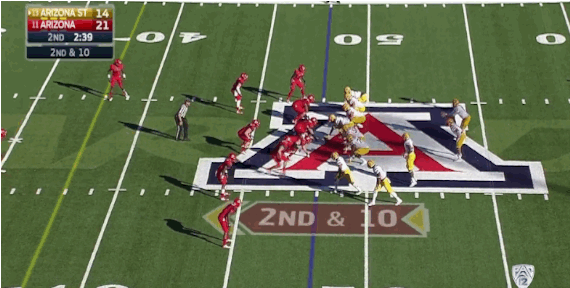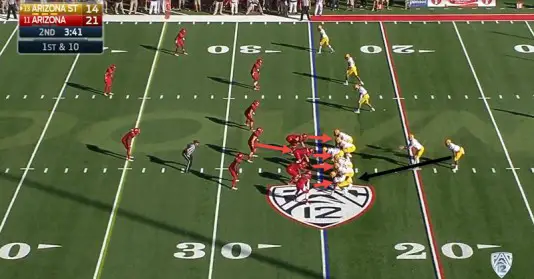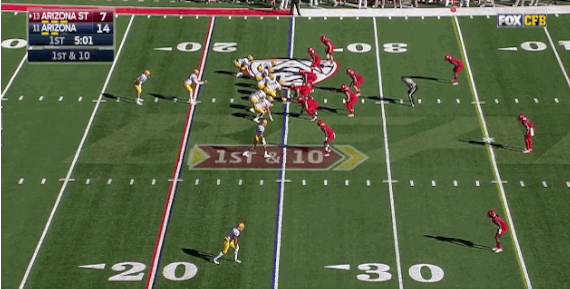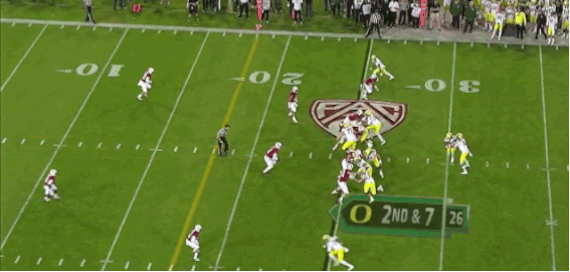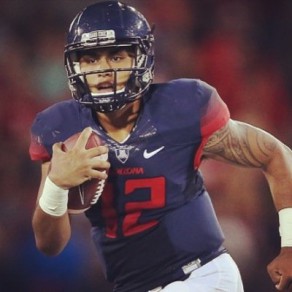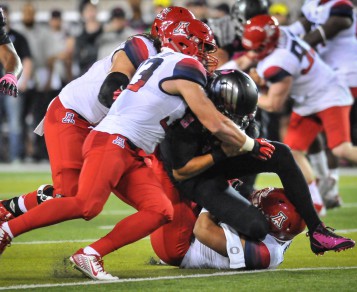OK, we are down to this last Pac-12 game. Win this and we’re in. It’s simple. Then again it’s not simple; there is a huge roadblock … some team named Arizona is in our way. I don’t think I need to recap the recent history with Arizona — it is a painful memory for the Ducks. The good thing about playing Arizona instead of Arizona State is that Coach Mark Helfrich is very familiar with the Wildcats and their likely game plan against us. Moreover, the last time a team allegedly “had the Ducks’ number” and tried to make it three in a row (hint: Stanford), our Ducks blew them off the field. On the other hand, the bad thing about playing Arizona — they have manhandled the Ducks in those past two meetings.
Now, when Oregon played Arizona back in October, I wrote an analysis for our game against Arizona. This game has much bigger implications, so this analysis will be a little different. I will zero in on some smaller things that killed Oregon in that previous match-up. This also means that it’s going to be very technical, so I’ll try my best to explain all the terms and concepts. However, if mystified — please do leave a comment. Now, on to the good stuff.
Something Arizona loves to do, and did during the past two meetings, is blitz multiple linebackers from a variety of places. This killed our depleted O-line the last time around, but hopefully it killed us because of just that — a depleted O-line. Either way, you can expect many blitzes designed to come through various gaps, so let’s look at those.
Arizona generally runs a 3-3-5 defense, which is ideal for trying to stop Oregon’s spread offense, with defensive linemen who can get to the passer and collapse the pocket when only rushing three. As you can see (above), there’s no easy way to tell if anyone is going to blitz.
At the snap, the right outside linebacker is going to blitz through the weak-side C gap. This blitz, like many of the Wildcats’ blitzes, is disguised superbly. Taylor Kelley, Arizona State’s quarterback, is thrown off by the blitz, and as the pocket collapses to his left, he starts to step up to his right.
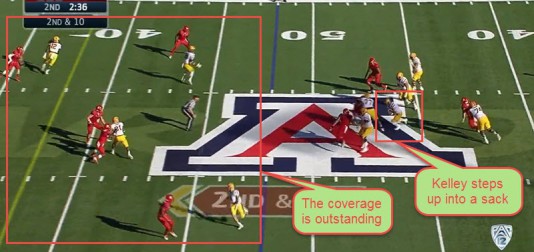
The coverage is air tight, so Kelley doesn’t have man to dump it down to and is forced to take a sack.
Kelley steps up right into pressure he can’t avoid and takes a sack. Arizona’s blitzes come from everywhere and with frequency. The offensive line’s ability to pick up the blitz will be a significant key to the game.
If they can successfully pressure Mariota and throw off his rhythm and timing, it could make for a long night. The Ducks’ offensive line will have to be coordinated and disciplined in order to hold off the blitz, and the running backs will have to be alert and agile to quickly identify when and where the blitzes are coming from, and step in to take on the additional rushers.
Although the blitz often works, especially for Arizona, if the offense calls the right play at the right time the result could be a big play for the offense, like the ones pictured (above and below). As you can see, the blitz comes from the left side of the defense, but the ball is run to the right side of the defense … away from the blitz. This is something Oregon needs to do, since it will neutralize the blitz and make the blitz favorable.
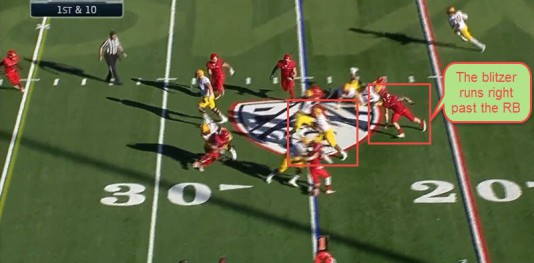
As you can see, the blitzing linebacker runs right past the running back, who ends up going for a big gain.
Scooby Wright III, Arizona’s linebacker and the recently-crowned Pac-12 defensive player of the year, reminds me of one other linebacker that was Oregon’s kryptonite — Shayne Skov of Stanford. Neither of them is athletically dominant, but they have some of the best instincts I’ve ever seen. You can see this most often on run plays outside the tackles.
Just take a look (above) at what Wright does from the inside linebacker position on DJ Foster, one of the most shifty running backs in the country.
Now look at what Skov did against Oregon last year (above). They both see the ball, and then shoot the gaps and take the quickest way from point A to point B.
Arizona is very tough to stop on offense, even with a redshirt freshman quarterback, Anu Solomon, running the show. The offense that Pac-12 Coach of the Year Rich Rodriguez has put together is predicated on forcing each defensive player to make a decision. Not only does Arizona run the standard option, but it also has a very effective run-pass option. Now, a defensive lineman is forced to choose whether to take the running back or the quarterback, and the linebacker(s) are forced to take away either the quarterback run or the pass. I highlighted this play and Arizona’s zone read in my previous article.
Along with a score prediction this week, here is a gameplan prediction. Remember the toss play Helfrich and Frost used back in October against Arizona? If doesn’t come to mind, take a look at this to jog your memory: skip to 30 seconds in and you will find the play. This was a one-of-a-kind play, with trickery thrown in to an even more unusual degree.
In order to counteract Arizona’s speed from sideline to sideline, there might be some trickery again tomorrow, or at least some new plays that stretch the field and make sure Arizona doesn’t over-commit to anything (or punish them if they do). I also expect hot-routes from the receivers because of the blitzes, so Mariota and his receivers better be on the same page.
To also help account for the blitzes, it might help if the Ducks slow the pace down just a bit. Yes, I know … yell at me … say what you want … call me idiotic … I can take it … but just hear me out. The best way to get a defense to show its hand, especially on a blitz, is to change the snap count often and utilize a hard count. A hard count is when you use a fake snap count to try and draw the defense offsides, or in this case, have the defense give the offense a “sneak-preview” of the pass rush. Often, the blitzing defenders will be forced to treat the hard count as the real snap because they want to get a good jump on the play, so when they do this, that will show Mariota and the rest of the offense where the blitz is coming from.
When Arizona adjusts to this, which it likely will, the Ducks should then just go back to their original speedy selves, as the defense won’t be able to get the best jump because it will be worried about tipping its hand as to the defensive scheme.
On a side note, I think that the Heisman is Mariota’s, even if he has just a mediocre game, if there is such a thing … knock, knock, knock, knock, knock, knock, knock … sorry, that’s just me knocking on every piece of wood in Eugene. This is taking nothing away from Melvin Gordon III, the superb running back out of Wisconsin, who is having one of the best, if not the best, running back seasons ever. This is just giving more credit to Marcus Mariota; if this was any other year, Gordon would be the runaway Heisman winner.
Go Ducks!
“Oh, how we love to learn about our opponents on FishDuck.com.”
Rory Davidson
Opponent Football Analyst for CFFNetwork/FishDuck.com
Eugene, Oregon
Top photo by Craig Strobeck
Related Articles:
Chip Kelly Update: Everything's Good Again ...
Chip Kelly Update: Wailing and Gnashing of Teeth
Shock and Awe -- The Oregon Ducks' Football Hangover Effect
Despite Lopsided Score, Georgia State "Never Stopped Believing"
Hope Springs Eternal for Ducks
Incompetent Pac-12 Officials: How Do You Miss ALL of THIS?
Rory Davidson: Rory (Football Analyst) is a sophomore at Oregon in the fall (Class of 2018). He has been a devout Stanford football fan since he was 2 months old and is excited about the energy and greatness Oregon sports has to offer. For the past 6 years he has been doing advanced data analytics for his high school football team and working alongside the coaches to understand how they strategize about the game. He wants to integrate more statistics into his analyses and try to help readers learn about and understand the future of sports.


